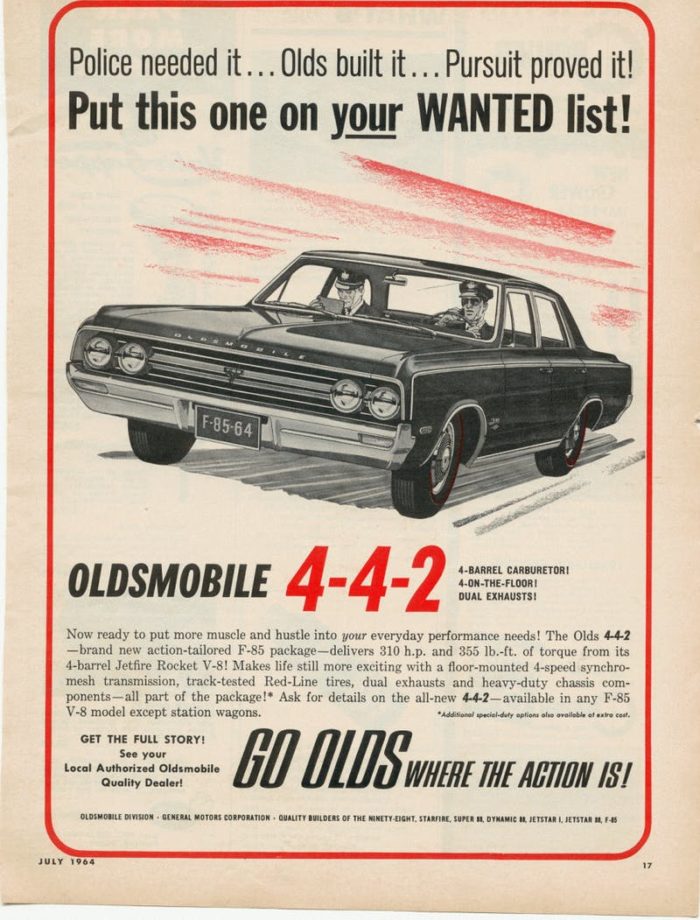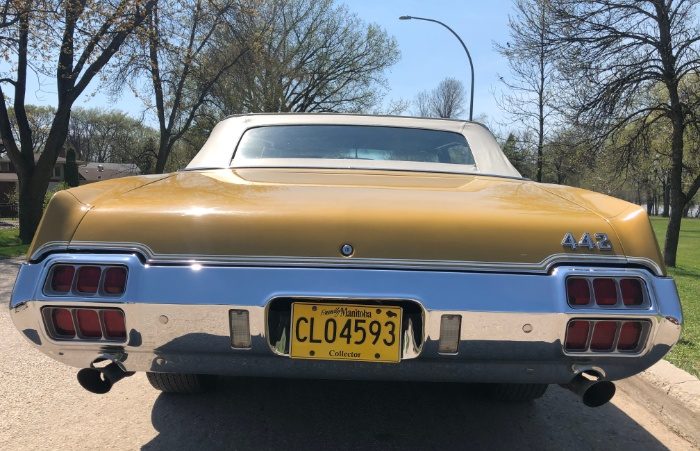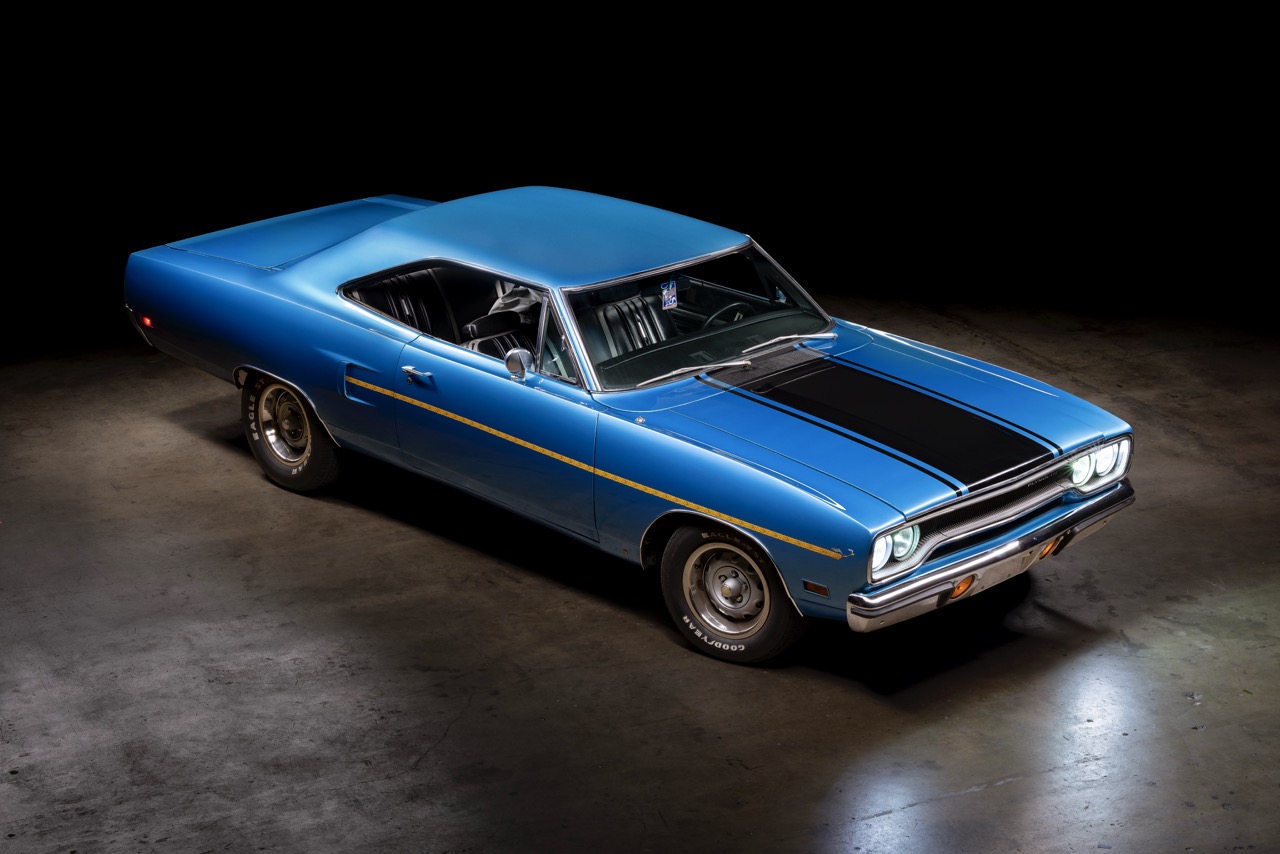The Rocket – Oldsmobile Cutlass 442 W-30

Oldsmobile was popular for many automotive breakthroughs but was never really seen as a performance brand among GMs hierarchy.
Throughout its century-long history, the company pioneered fundamental technologies well before its competition and advanced the US automotive industry more than people realize.
Oldsmobile gave us chrome trim plating, the first standard windshield, the first production fully-automatic transmission, overhead valve engines, turbochargers – yes, way back in 1962. America received its first modern front-wheel-drive car – the Oldsmobile Toronado – which also became the first US car with a microprocessor ECU.

Even when the brand had already lost its market place at the dawn of the new millennium, Oldsmobile remained a hotbed for emerging automotive technologies.
The race for horsepower
While it didn’t have Pontiac’s reputation among the performance crowd, Oldsmobile was never a slouch in the go-fast department.
In fact, it’s arguable that Oldsmobile gave America its first-ever muscle car in 1949 with the Super 88. Yes, Oldsmobile first combined the relatively small and light B-body platform with its novel Rocket 88 power plant – a 303 ci (5.0 liter) overhead-valve, V8 engine, producing 135 horsepower and 253 lb-ft of torque.
This is not even average today, but it was massive back in the day.

Fifteen years later, the muscle car war was about the burst. All manufacturers were racing to put bigger and bigger engines into smaller and smaller cars to make them that much faster. The competition was fierce, not only in the US market but also internally within the big three.
All GM divisions, except Cadillac, were locked in a performance battle.
Full-sized cars had large big-block engines, but were heavy and handled like land-yachts. GM granted all divisions with the A-body platform to create their own mid-sized cars, however, they established a corporate cap on engine size. Intermediate cars would be limited to engines with 330 cubic inches of displacement maximum.
Pontiac found the loophole first.

As all great GM products, the way to bend the rules was to make your new car as an optional package for an existing model. By designating the GTO as an option package for the Tempest / LeMans, Pontiac was free to equip it with the 389 ci big-block V8 producing 325 horsepower.
And thus, the 1964 Pontiac GTO became the standard definition for what a muscle car is.
The move caught Buick and Chevrolet unprepared, but ever eager to adapt and innovate, Oldsmobile launched a competitor that same year.
Cutlass 442 – The legendary Oldsmobile muscle car
In 1964, Oldsmobile launched the 442 – a top tier performance package for the mid-size Cutlass and F-85.
The initial offering was not great – a last-minute attempt to repurpose the “B09 Police Apprehender Pursuit” package into a performance model.

Olds still obeyed GM policy and equipped the 442 with a 330 cubic-inch engine. The Rocket V8 featured heavy-duty valve train, performance camshaft, and a four-barrel carburetor. Total power was 310 hp and 355 lb-ft of torque.
The 442 also got a 4-speed, floor-shifted Muncie transmission, heavy-duty driveshaft, and 3.36 rear end. Police heavy-duty suspension and big brakes completed the package.
The name 442 is actually an acronym for 4-barrel exhaust, 4-speed floor-shifted manual transmission, dual exhaust. Of course, later on, the definition got blurred with the introduction of numerous drivetrain options.

By all means, the 442 was quick the time, but not quicker than Pontiac’s GTO. The Olds 442 launched to 60 mph in 7.5 seconds versus 6.6 seconds for the GTO. Similarly, it was almost a second slower in the quarter-mile.
Interestingly, the 442 reached a higher top speed – 116mph versus 99mph for the GTO. However, that was not enough to make the car desirable. The F-85 / Cutlass had a reputation for an average, not-particularly-fast car. Olds only sold 3,000 units for 1964. Pontiac sold more than 32,000 GTOs.
In the following year, Oldsmobile received permission to use their 400 ci engines, bumping up power to 345 hp and 440 lb-ft of torque.

By 1966, all GM divisions had intermediate muscle car offerings. Chevrolet introduced the Chevelle SS396 and the El Camino SS396. Buick launched the GS400.
To maintain its advantage, Oldsmobile created the W-30 performance package for the already muscular 442.
The W-30 included a cold-air induction system and an even more aggressive camshaft. With 360 horsepower on tap, the 442 was able to go from 0 to 60 mph as quickly as 6.3 seconds. A dealer-installed 4.33 rear end allowed the car to run the quarter-mile in 14.1 seconds.
Though it always lived under the shadow of the GTO, Oldsmobile 442 was a true muscle car with legendary performance that was fully competitive with anything else in the street.
In 1968 all, intermediate cars received a full redesign.

The coke bottle style was introduced and the cars became curvaceous. The previously block-shaped body received a new smooth silhouette featuring a semi-fastback rear end and massive C-pillar buttresses. Two-door Cutlass and 442 models now had a shorter wheelbase of 112 inches (3 inches shorter).
Oldsmobile kept the dumbbell-style front end, though separated and framed the dual headlights. I’m a sucker for coke-body styling, but I’m personally more fond of the 1967 front clip design with a single cavity for the headlights and grille, outlined neatly in chrome.
The 442 evolved from a trim package to a stand-alone model. It was still equipped with a 400 cubic-inch V8, but it was an entirely new design, sharing components with the Oldsmobile’s largest 455 engine. Power remained the same, but thanks to a new camshaft, the engine produced peak torque at 3,000–3,200 rpm vs 3,600 rpm on the previous design.
The Olds / Hurst 442
In 1968, Oldsmobile and Hurst partnered to created the Hurst/Olds 442 special edition model.

Powered by the 455 ci Rocket V8, the Hurst/Olds offered 390 horsepower and 500 lb-ft of torque.
At the time, GM still upheld a displacement limit of 400 cubic inches for all A-body cars. This time it was Oldsmobile that found the loophole and beat Pontiac at their own game.
Since it was not an entirely GM vehicle, Oldsmobile claimed they were giving the bodies and engines to Hurst to install at their own facility. In reality, the cars came equipped with their powertrains out of the Lansing factory and then taken to Hurst for further modification.
Mated to the big-block V8 was a 3-speed Turbo-Hydramatic transmission with a console-mounted Hurst Dual-Gate shifter, which permitted either manual or automatic gear changes.
The first year, Hurst / Olds looked somewhat conservative with its silver paint and black stripes. From 1969, the car received the gold treatment and the ram air system was delegated to new functional hood scoops.
Now the car looked as mean as it drove, and personally, I think the Hurst / Olds offers the best color scheme to ever dress a Cutlass.

Hurst and Oldsmobile continued their partnership and produced special edition cars all the way to 1988 until the A-body rear-wheel-drive platform was eventually discontinued.
Oldsmobile reached peak performance in the early 70s
The year was 1970 and the muscle car war reached levels of brutality which have never been seen before or after.
Mopars were running around with the RB 440 big-block with 390 hp and 490 lb-ft of torque on tap even though cars of the day were barely able to remain structurally sound at such power levels.
GM had to up the ante and removed the engine size cap for the intermediates. Every division answered expectedly and proceeded to install the biggest engines they had into their respective A-body car.

Finally, Oldsmobile could offer the 442 with its Rocket 455 V8 engine from the factory with 365 hp and 500 lb-ft of torque.
The W-30 package added a fiberglass hood with functional intake scoops, low-restriction air filter, aluminum intake manifold, new camshaft, cylinder heads, distributor, and carburetor. The upgrades gave the 442 a total of 370 horsepower which helped the car run a quarter-mile as quickly as 13.7 seconds, as observed by Motor Trend.
Where the front end of the car looked somewhat dorky and conservative in 1968, Oldsmobile continued to evolve the design.

The dual headlights were clumped closer together and the grille was split down the middle in 1969. In 1970, they added the vertical slats and made the headlights even bolder.
At this point, the Olds 442 was looking properly aggressive and dominant – just what you want from a muscle car. And this wasn’t even its final form.
The same year, the Olds 442 was the designated pace car of the Indianapolis 500. A 1970 model also played in the chase scene of the 1993 movie Demolition Man, starring Sylvester Stalone and Wesley Snipes.
In 1971 power levels dropped as GM enforced a corporate-wide reduction of compression ratios. Performance had peaked and was irreversibly headed downhill as manufacturers embraced that the carefree days of unrestrained power were over.
However, that didn’t stop designers to push the envelope further. The ultimate Oldsmobile 442 design came in 1971.
What used to be a split grille transformed into a pair of deep cavities wrapped in chrome trim and leading directly to the blacked-out radiator. The car looks absolutely vicious, but not over the top.

Olds designers created the ideal proportions which resonate perfectly with the induction hood scoops. The new round parking light was centered between the dual headlights creating a triangle, the sides of which repeat other lines in the front end.
It’s a celebration of design and geometry – three lights arranged in a triangle, three rectangular openings arranged vertically on top of each other. Everything fits perfectly.
The survivor – 1972 Oldsmobile Cutlass 442 W-30
With the impending death of the muscle car, Oldsmobile reverted the 442 back to an appearance and handling package for the Cutlass. Heavy-duty springs, shock absorbers, and rollbars were added front and back, as well as boxed lower control arms in the rear and 14-inch wheels all around.

The W-30 option still offered the Rocket 455 V8 with an aluminum intake and the ram-air hood, but at this point, it only produced 300 hp and 410 lb-ft of torque.
Still, a limited-slip differential and heavy-duty cooling system ensured that whatever performance was left could be reliably extracted from the 442.
However, fewer than a thousand enthusiasts purchased a 442 W-30 in 1972. One of them was Richard Elias’ aunt.
She got the Olds brand new from the factory – a 2-door Cutlass Supreme convertible with the 442 and W-30 packages. Only 113 of these were produced in 1972. And the fact that it came with the automatic transmission makes this one even rarer.
It stayed in the family for 48 years and counting.

Eventually, the car was purchased by Richard’s father.
This is a 100% original, matching numbers car. It’s virtually unmodified minus the addition of a tachometer where the analog watch once lived. The engine has never been rebuilt or taken out of the car. The only repair it’s seen is a valve cover gasket replacement.
At some point, the 442 was in need of paint intervention.

So, Richard’s father took on the mammoth task of doing his own bodywork. The man was a mechanic, but not a painter. Still, he painstakingly stripped down the paint then treated the 442 with a coat of the original Saturn Gold. He did his own stripes and even painted the wheels.
When all meticulous work was finished and it was time to back it out of the shop, Richards’s dad accidentally drove the car into a trailer.
“He was extremely disappointed… It must have been devastating.”

Richard’s father cherished his 1972 Oldsmobile 442 dearly and kept it in his shop and under a cover for most of its life. The car was always around, but neither of its owners didn’t seem to drive it much. And after his passing in 2015, the 442 got passed down to Richard himself.
Richard was never a project car type of man and neither was he into classic muscle cars. But he plans to keep this one around for now, in memory of his dear father.
Recent Posts
-

Reegan Is Building This 1975 Dodge Ramcharger For One Lucky YouTube Subscriber
August 13, 2025Update 08/15/25: Reegan now has an all new aluminum radiator installed with dual electric fans. The Wilwood master cylinder is installed along with an EvansCNC…Read more -

Let's Turn a 1970 Plymouth Roadrunner into RestoMods Royalty
August 8, 2025Update: 8/8/2025 A little over a year ago we purchased a beautiful 1970 Plymouth Roadrunner from a local collector car dealership Bayside Auto. We knew…Read more -

The Ultimate 1968 Dodge Charger HELLCAT Build
August 8, 2025Update 8/8/25: Back in January of 2024, we purchased a 1968 Charger shell from Mopars 5150. They specialize in all things Mopar and had a…Read more
Become a Car Club Member
Car Club Members Get Entries to Win, Discounts in our Shop, Discounts with our Preferred Partners and more!
Membership benefits
By joining the RestoMods Car Club Today, you will receive amazing perks plus 15 bonus entries into our sweepstakes for every month you are an active member
-
Auto Discounts:Curated Discounts From Your Favorite Parts Companies
-
Restomods Monthly:Monthly Magazine With The Latest Industry News
-
Classified Ads:Get Free Postings seen by 300,000 enthusiasts monthly
-
Car Show Tickets:Check out the biggest vintage car shows on us.
-
Exclusive Car Deals:First chance to purchase any prize cars not selected






Restomods on Instagram
Follow us on Instagram and other networks












